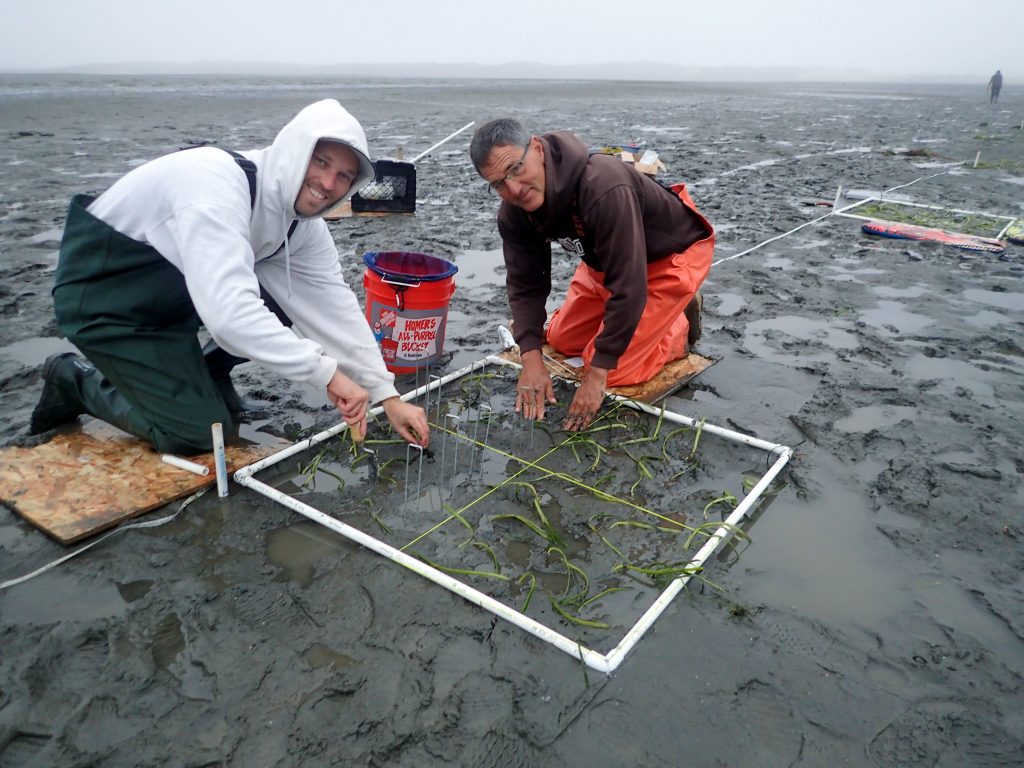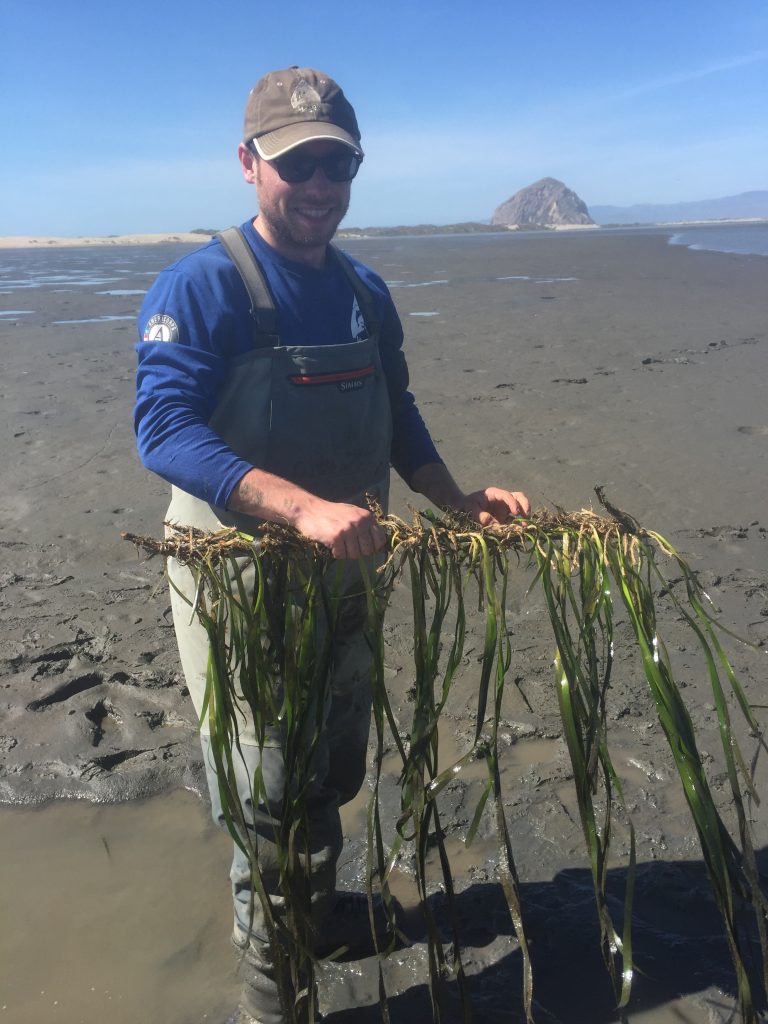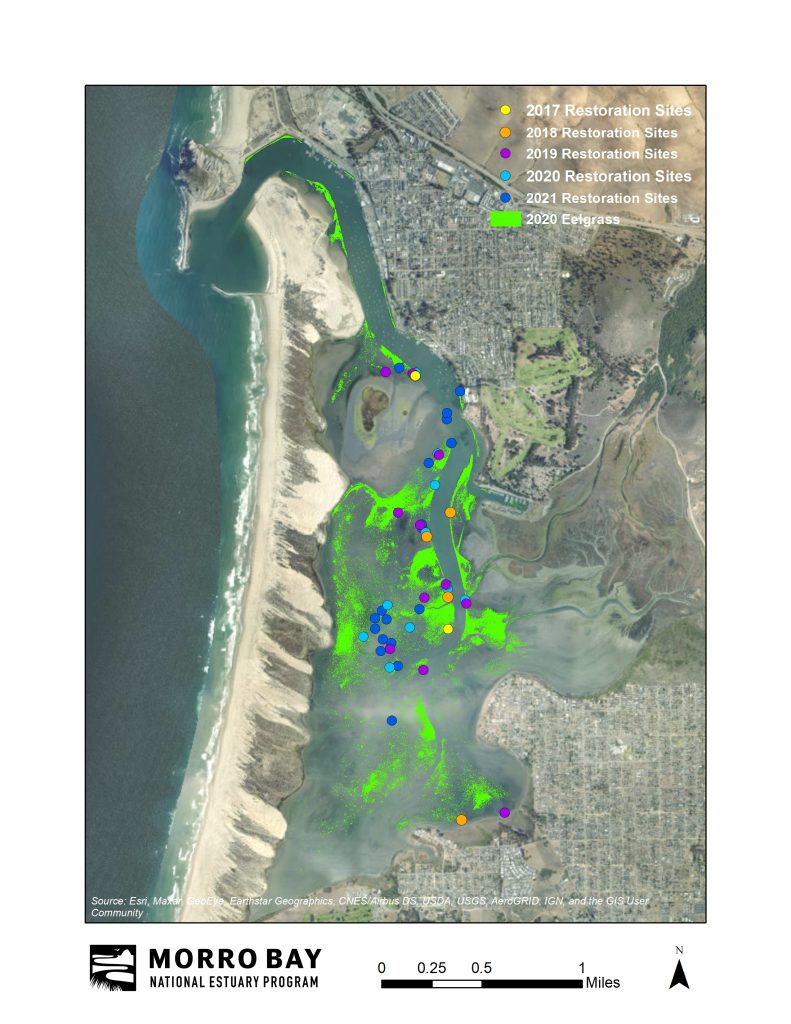In 2017 when our mapping effort revealed only 13 acres of eelgrass in the estuary, the Estuary Program and other entities began pilot restoration efforts to bring back eelgrass. These efforts focused on transplanting eelgrass in areas with loss to expand the habitat. Each year the scale of eelgrass planting increased. With eelgrass acreage in Morro Bay reaching historic highs with 500 acres recently mapped, we are taking a look at the Estuary Program’s eelgrass restoration efforts and the lessons we have learned, as well as expressing gratitude for our volunteers and partners.
Eelgrass Decline: 2007-2016
In 2007, the Estuary Program’s baywide map showed 344 acres of eelgrass. Over the next decade, eelgrass acreage declined to 13 acres. During this decline, eelgrass coverage was most stable towards the front of the bay closer to the harbor entrance. Eelgrass was harvested from different locations and varying depths to increase the diversity of what was transplanted.
Restoring and Replanting: 2017-2022
Between 2017-2022, we transplanted over 15,000 plants from healthy donor beds to areas with eelgrass loss. We learned effective restoration strategies such as the optimal time of year, anchoring methods, and locations. In 2017, we planted at two pilot sites with one transplant method at two different times of year. Our anchoring method worked well, and we found that spring was the best time of year to plant.

In 2018, we tested a new anchoring method where eelgrass was tied to rebar which could be removed once the roots were established. We tested transplanting at five locations throughout the bay.

We expanded our efforts to 10 sites in 2019 and tested a wider range of depths. Much of the eelgrass in Morro Bay tends to grow at fairly shallow depths. We found that sites planted at deeper depths had slightly higher survival rates with nine out of 10 sites successful after one year.


Increasing Plantings
As our early efforts showed a high rate of transplant survival, we greatly increased our scope of plantings in 2020 (almost 4,000 plants) and 2021 (over 5,000 plants). In 2020, we tested anchoring with bamboo pieces in addition to rebar and expanded to deeper sites using scuba. We found that bamboo was a fast and effective method for planting. In 2021, we focused on increasing our total plantings with bamboo. Natural eelgrass expansion was also occurring in 2021, making it challenging to monitor transplant success as separate planted areas were merging together in just six months. In most years, sites were monitored for survival at three, six, and 12-months post planting.

Restoration Lessons Learned
Through this work we’ve learned many valuable lessons:
- Spring is the best time to transplant eelgrass, potentially due to improved water quality and reduced macroalgae during those months.
- Transplanted eelgrass did well with all transplant methods and with eelgrass from all donor beds, which included Coleman Beach, Tidelands Park, and beds along the sandspit.
- Transplanted eelgrass thrived at the majority of sites, roughly 34 out of 41. Sites with lower transplant success seem to be located at higher elevations or in areas dominated by macroalgae.
Improving our Understanding of Estuary Conditions
Beyond our restoration efforts, we’ve also expanded our monitoring and research projects related to eelgrass and bay health. The Estuary Program has partnered closely with Cal Poly, Cuesta College, and other partners to better understand possible impacts to eelgrass and expand monitoring of water quality, nutrients, and bathymetry.

Building Partnerships & Community Support for Eelgrass Recovery
We are grateful for the many partners and community volunteers who joined us in eelgrass restoration and monitoring efforts. The work would not have been possible without this support! From 2017 to 2022, our volunteers spent nearly 500 hours getting wet and muddy while helping to harvest and plant eelgrass. Some people came out for a few hours, while others returned to help year after year. Cal Poly and California Sea Grant staff played a large role in developing initial experiments to determine the optimal restoration and monitoring methods. Tenera Environmental, Inc., a local consulting firm, also supported our eelgrass efforts and more recently led the majority of planting as COVID made it challenging to use volunteers.
A huge thank you to our community volunteers, including the AmeriCorps Watershed Stewards Program.
Thank You for your Support
The Estuary Program has largely supported our eelgrass restoration work through grant programs such as the California Department of Fish and Wildlife Duck Stamp, Pacific Marine Estuarine Fish Habitat Partnership, Restore America’s Estuaries Coastal Watershed Grant, U.S. Fish & Wildlife Service Coastal Watershed Grant, and NOAA Sea Grant. The effort also benefited from donations from the Black Brant Group from community members. We are grateful to the many funders who helped make this work possible.
Help us protect and restore the Morro Bay estuary!
- Donate to the Estuary Program today and support our work in the field, the lab, and beyond. The Estuary Program is a 501(c)3 nonprofit. We depend on funding from grants and generous donors to continue our work.
- Support us by purchasing estuary-themed gear from ESTERO. This locally owned and operated company donates 20% of proceeds from its Estuary clothing line and 100% of Estuary decal proceeds to the Estuary Program. Thank you, ESTERO!
- Purchase items from the the Estuary Program’s store on Zazzle. Zazzle prints and ships your items, and the Estuary Program receives 10% of the proceeds.
Thank you for helping our beautiful, bountiful, biodiverse bay!